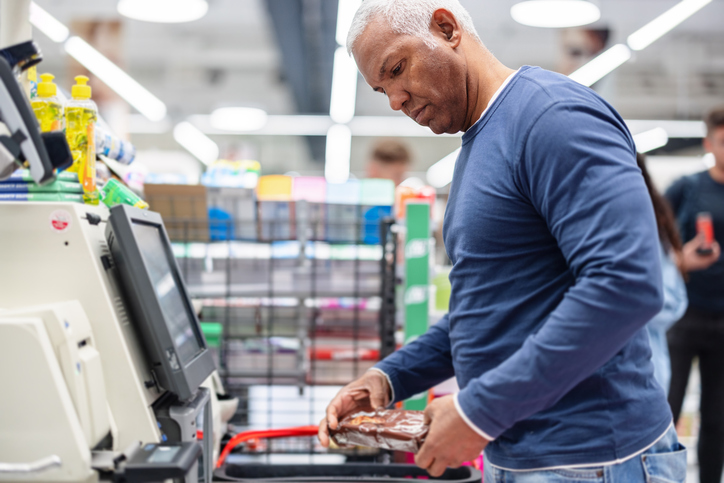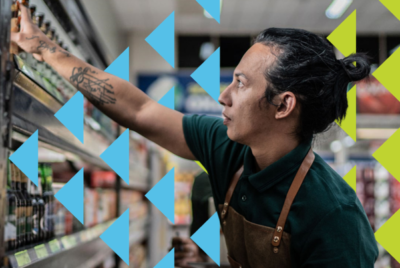New technology often brings with it a requisite period of adjustment. But when that technology is implemented while it’s still evolving, the results — and its reception — are often uneven.
Take self-checkout, for instance. Considered revolutionary in the grocery business when it first came on the scene in the 1980s, it’s now commonplace but not all shoppers are fully on board. Judging by some of today’s headlines questioning whether “self-checkout is dead,” you might think the tech is on the verge of being eliminated.
The truth is far more complicated, according to the 2024 Advantage Shopper Outlook survey.
Concerns raised by some retailers in recent months are valid. Theft and loss can be more acute in unstaffed lanes, and unintentional errors are more common when fewer folks are around to ask for help, which forces harried shoppers to troubleshoot on their own.
But self-checkout is certainly not dead.
Not only is it not dying, self-checkout is thriving, particularly among entire demographics of consumers who’ve come to appreciate the convenience, the relative privacy and the suitability for their lifestyle that self-checkout offers.
“Self-checkout is not, as one recent article called it, a failed experiment,” says Andy Keenan, executive vice president at Advantage Solutions. “It’s actually part of the next evolution of the retail customer experience, and evolutions take time.”
A new-ish technology that fills a marked need
Self-checkout first appeared in 1986 but did not achieve widespread adoption until some 20 years later. In the long history of retail innovation, it remains a fairly new concept, one meant to improve efficiency for both consumers and retailers.
For consumers, self-check can offer a speedier checkout experience, as more ”open” registers usually mean shorter lines and a quicker exit from the store.
For retailers it provides a critical labor solution, as the availability of quality hourly workers is as limited as it has ever been. Self-service lanes allow retailers to reduce front-end hourly labor needs, allowing them to redeploy those workers into aisles or stock rooms.
“Since the pandemic, there’s been a revolution on hourly labor,” Keenan says. “Labor in certain markets that would cost you $16 an hour now costs you $19 or $20 an hour, and it’s a gig economy. The people who once stood at a checkout stand in the front of a store are now driving for Instacart or DoorDash because the hours are more flexible. They want to make their own schedule, and it’s varied work. Today, most retailers can’t offer that.”
Self-checkout technology has helped enable that drive for workforce flexibility, but Keenan says it has also empowered more efficient store operation, requiring less or different types of labor. “That’s part of the journey, and that is not going to change.”
Keenan draws a comparison between the evolution of self-checkout and online grocery delivery, which retailers quickly perfected in the wake of the pandemic. One is evolving from a desire to save time and money and consumers’ desire to avoid being inconvenienced. The other evolved out of necessity, which naturally sped up its adoption and operational efficiency — though there are still occasional hiccups.
“The notion that we’re going to pivot away from technology that helps offset labor needs and will ultimately continue to improve customer experience because of some challenges is far-fetched,” Keenan says. “We need to continue to embrace the technology and realize that it may always be imperfect, but it will always be evolving. The noise that, ‘Oh, self-checkout might not be working,’ that’s just a moment in time.”
Who is the self-checkout shopper?
Self-checkout appeals to shoppers who enjoy convenience, and those whose lifestyle situations make traditional shopping structures less appealing. Many who’ve adopted it and prefer the option tend to skew younger, belong to diverse groups and have little ones in tow.
Shoppers with younger children want to get in and out with as little fuss as possible, with some 59% of these households reporting that having a self-checkout option is an important part of their shopping experience, according to data from the Advantage Shopper Outlook, a survey of more than 8,000 U.S. shoppers. Those without kids aren’t far behind, with 50% reporting that self-checkout is important.
Shoppers of color also are more likely to prefer self-checkout, survey data show. Half of Black/African-American shoppers and 59% of Latinos say self-checkout is important largely because they prefer privacy and perceive un-staffed lanes as a “no-judgement zone.” Self-checkout also affords less personal interaction — and less likelihood of friction.
Where consumers shop also matters. Those who do their shopping at Target, Whole Foods and Walmart are more likely to list self-checkout as important than their counterparts, data show. Some 61% of Target shoppers prioritize self-checkout, a far higher percentage than any other retailer.
So, who are the holdouts? Just 14% of Gen Xers with older children say self-checkout is important. These shoppers may have more time and appreciate the in-person service they’ve grown to expect at retail. They’re also more likely to use shopper loyalty coupons and in-store circulars.
A technical destination for retailers and shoppers
From a consumer perspective, self-checkout has significant value — depending, of course, on the consumer.
The store environment also can have a significant impact on the shopping experience because shoppers who prefer self-checkout often have a heightened awareness of their surroundings compared to the average shopper. Lighting, cleanliness, signage, the number of store associates available for questions as well as services like a hassle-free return policy and convenient store hours all play into the shopping experience.
Ultimately, self-checkout is part of a technology journey that consumers and retailers are on together, but it’s not the ultimate destination, Keenan says.
“Look at what Amazon is doing with its ’Just Walk Out‘ technology,” he explains. “That’s an amazing proof point, and as great and strong as self-checkout capability is — and can be — it’s still being refined. We’re headed toward technology that ensures consumers do not wait in any lines at all, and technology unlocks that experience.”
Further, Keenan says, consumer adoption will continue to increase over time as retailers embrace new technology and tools to promote efficiency, ease of use for shoppers and determine the optimal level of live support needed to staff self-checkout lanes.
Yes, but what about shrink?
Aside from typical tech-related bumps in the road, retailers have faced other challenges around self-checkout, including increased shrink due to both shopper theft and unintentional human error. But these challenges are not insurmountable, Keenan says.
As technology advances and matures, the consumer experience will continue to improve. At the same time, Keenan says retailer shrink should decline because evolving technology will help to catch and prevent user mistakes.
“A lot of shrink is human error,” he explains. “But it will vary from retailer to retailer and market to market. Self-checkout is imperfect, but as it evolves, the technology will push us forward.”
Consider, despite documented challenges, the number of self-checkout lanes has increased 10% over the last five years. Those lanes account for nearly 40% of all checkout options across U.S. grocery, according to data from Catalina. Retailers must be doing something right.
For more self-checkout shopper insights, download the 2024 Advantage Shopper Outlook survey.




